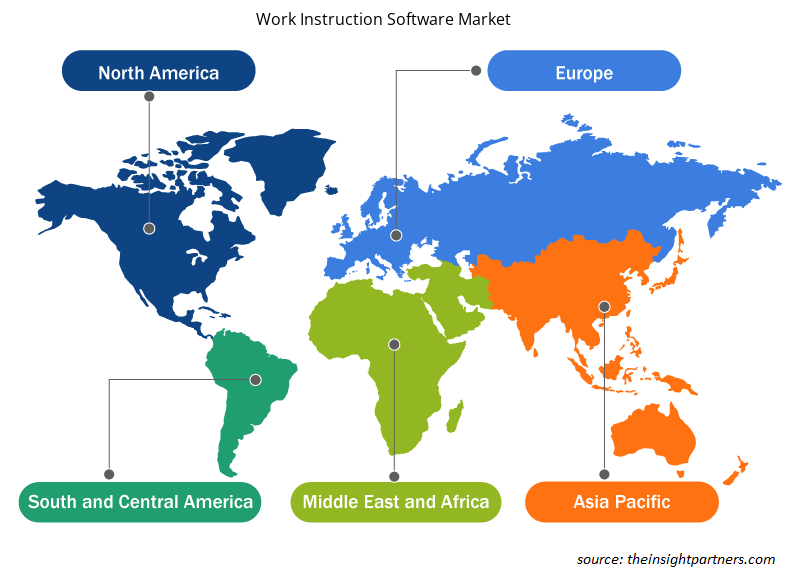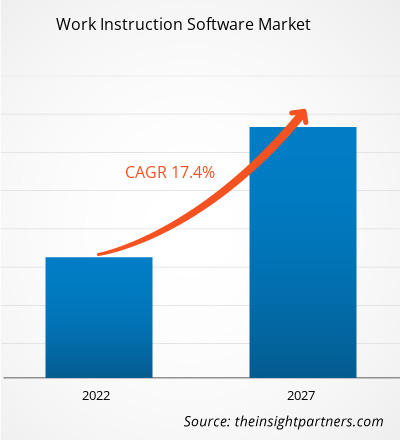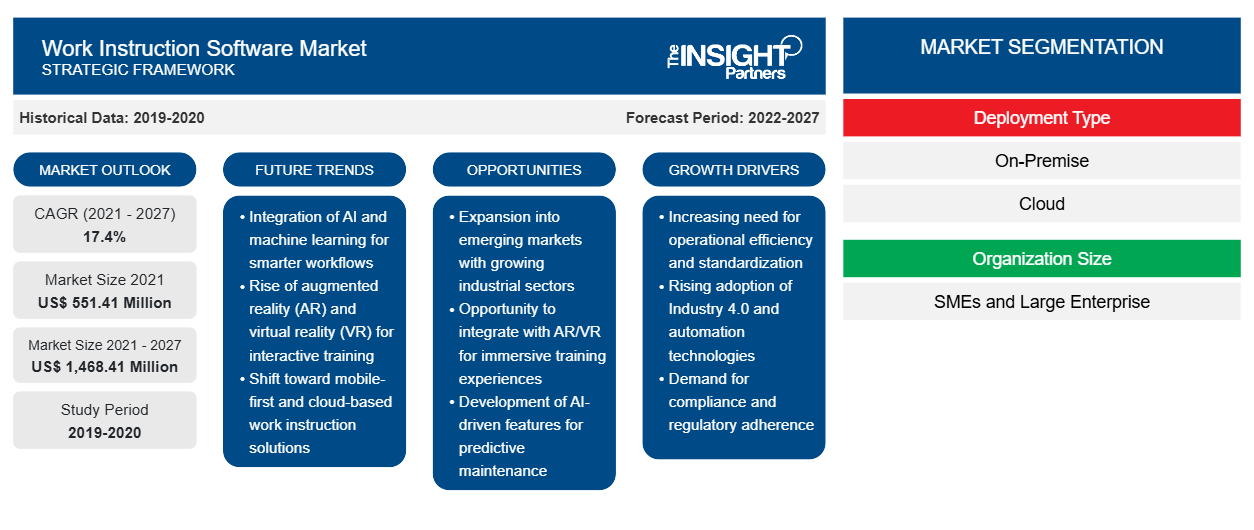Si prevede che il mercato del software per le istruzioni di lavoro crescerà da 551,41 milioni di dollari USA nel 2021 a 1.468,41 milioni di dollari USA entro il 2027. Si prevede che il mercato del software per le istruzioni di lavoro crescerà a un CAGR del 17,4% durante il periodo di previsione dal 2020 al 2027.
Il fattore chiave che guida il mercato è la continua evoluzione delle complessità aziendali e produttive. L'adozione di un processo di produzione di modelli misti per migliorare la produttività manifatturiera complessiva dell'organizzazione sta creando la necessità di una formazione e uno sviluppo migliorati tra i dipendenti. Ciò alimenta quindi l'adozione di software di istruzioni di lavoro nel settore manifatturiero. La necessità di formazione dei dipendenti per migliorare la produttività sta portando all'adozione di soluzioni tecnologicamente avanzate in tutte le aziende. La crescente complessità del processo di lavoro in settori quali produzione, automotive, sanità e vendita al dettaglio sta aumentando la domanda di istruzioni di lavoro tra dipendenti e operai per svolgere il proprio compito in modo indipendente ed efficiente. Ad esempio, Augmentir, Inc. offre una piattaforma di forza lavoro connessa basata sull'intelligenza artificiale per aiutare i dipendenti con flussi di lavoro digitali e guida remota durante tutto il processo di lavoro.
Sta diventando evidente, con la pandemia di COVID-19 che si sta diffondendo in tutto il mondo, che pochi possono sfuggire al suo ambito, presentando sfide significative per tutti i settori. Tuttavia, la principale applicazione del software è nel settore manifatturiero, dove lo stesso viene applicato per impartire formazione ai dipendenti in merito al funzionamento di determinati macchinari. Pertanto, si prevede che la chiusura di tutte le unità produttive sia nei paesi sviluppati che in quelli in via di sviluppo avrà un impatto negativo sulla crescita del mercato del software per l'istruzione lavorativa .
In base al tipo di distribuzione, il software di istruzione di lavoro è segmentato in on-premise e cloud. Si prevede che le soluzioni basate su cloud cresceranno con il CAGR più elevato nel periodo di previsione. Inoltre, il mercato del software di istruzione di lavoro in base alle dimensioni dell'organizzazione è segmentato in PMI e grandi imprese. Le grandi imprese hanno rappresentato la quota maggiore del mercato. Il mercato globale del software di istruzione di lavoro è stato segmentato in cinque regioni principali: Nord America, Europa, APAC, MEA e SAM.
Personalizza questo report in base alle tue esigenze
Riceverai la personalizzazione gratuita di qualsiasi report, comprese parti di questo report, o analisi a livello nazionale, pacchetto dati Excel, oltre a usufruire di grandi offerte e sconti per start-up e università
-
Scopri le principali tendenze di mercato in questo rapporto.Questo campione GRATUITO includerà analisi di dati che spaziano dalle tendenze di mercato alle stime e alle previsioni.
Approfondimenti sul mercato del software per istruzioni di lavoro
Cambiare la cultura del lavoro in tutta l'organizzazione
La tendenza crescente di Bring Your Own Device (BYOD) unita alla cultura del lavoro da remoto in tutte le organizzazioni, in particolare nelle grandi aziende, sta creando la necessità di soluzioni di istruzione sul lavoro per garantire il regolare funzionamento all'interno dell'organizzazione. La cultura del lavoro flessibile nelle organizzazioni ha portato alla non presenza dei dipendenti dai locali dell'ufficio, il che causa interruzioni nel flusso di lavoro, in particolare per i dipendenti di livello junior che necessitano di assistenza continua per apprendere ed eseguire lavori per l'acquisizione degli obiettivi. L'integrazione di soluzioni di istruzione sul lavoro in tutte le organizzazioni consente quindi ai datori di lavoro di istruire tutti i dipendenti senza che la barriera fisica influisca sull'efficienza della produzione.
Approfondimenti di mercato basati sul tipo di distribuzione
In base al tipo di distribuzione, il mercato globale del software di istruzione di lavoro è segmentato in distribuzione basata su cloud e on-premise. Il software di istruzione di lavoro basato su cloud sta assistendo a un'elevata domanda rispetto al software di istruzione di lavoro on-premise. Il segmento cloud genera la maggior parte della domanda poiché è relativamente meno costoso e grazie alla solida infrastruttura di rete nei paesi sviluppati. Inoltre, i fornitori di software di istruzione di lavoro basati su cloud sono altamente concentrati sullo sviluppo di una patch di sicurezza di alto livello per eliminare il rischio di attacchi informatici. Questo fattore sta anche creando una domanda significativa da parte degli utenti finali, guidando così il mercato del software di istruzione di lavoro.
Approfondimenti di mercato basati sulle dimensioni dell'organizzazione
In base alle dimensioni dell'organizzazione, il mercato del software per le istruzioni di lavoro è segmentato in PMI e grandi imprese. Il crescente investimento in infrastrutture manifatturiere sia nei paesi sviluppati che in quelli in via di sviluppo sta determinando in modo significativo la domanda di software per le istruzioni di lavoro tra le PMI.
I player che operano nel mercato del software per istruzioni di lavoro si concentrano su strategie, come iniziative di mercato, acquisizioni e lanci di prodotti, per mantenere le loro posizioni nel mercato del software per istruzioni di lavoro. Ecco alcuni sviluppi dei player chiave del mercato del software per istruzioni di lavoro:
Nell'aprile 2020, SwipeGuide ha stretto una partnership con XMReality per implementare istruzioni di lavoro digitali utilizzando il supporto remoto.
Nell'ottobre 2019, Georg Fischer Signet ha implementato AssemblyX di Lifecycle Technology Ltd per la strumentazione di lavoro.
Approfondimenti regionali sul mercato del software per l'istruzione sul lavoro
Le tendenze regionali e i fattori che influenzano il mercato del software di istruzione sul lavoro durante il periodo di previsione sono stati ampiamente spiegati dagli analisti di Insight Partners. Questa sezione discute anche i segmenti del mercato del software di istruzione sul lavoro e la geografia in Nord America, Europa, Asia Pacifico, Medio Oriente e Africa e Sud e Centro America.

- Ottieni i dati specifici regionali per il mercato del software di istruzione sul lavoro
Ambito del rapporto di mercato sul software di istruzione di lavoro
| Attributo del report | Dettagli |
|---|---|
| Dimensioni del mercato nel 2021 | 551,41 milioni di dollari USA |
| Dimensioni del mercato entro il 2027 | 1.468,41 milioni di dollari USA |
| CAGR globale (2021 - 2027) | 17,4% |
| Dati storici | 2019-2020 |
| Periodo di previsione | 2022-2027 |
| Segmenti coperti |
Per tipo di distribuzione
|
| Regioni e Paesi coperti |
America del Nord
|
| Leader di mercato e profili aziendali chiave |
|
Densità dei player del mercato del software di istruzione sul lavoro: comprendere il suo impatto sulle dinamiche aziendali
Il mercato del software per le istruzioni di lavoro sta crescendo rapidamente, spinto dalla crescente domanda degli utenti finali dovuta a fattori quali l'evoluzione delle preferenze dei consumatori, i progressi tecnologici e una maggiore consapevolezza dei vantaggi del prodotto. Con l'aumento della domanda, le aziende stanno ampliando le loro offerte, innovando per soddisfare le esigenze dei consumatori e capitalizzando sulle tendenze emergenti, il che alimenta ulteriormente la crescita del mercato.
La densità degli operatori di mercato si riferisce alla distribuzione di aziende o società che operano in un particolare mercato o settore. Indica quanti concorrenti (operatori di mercato) sono presenti in un dato spazio di mercato in relazione alle sue dimensioni o al valore di mercato totale.
Le principali aziende che operano nel mercato del software per le istruzioni di lavoro sono:
- Tecnologia del ciclo di vita Ltd
- Gestione della conoscenza Livepro
- Guida di scorrimento
- Passi dello schermo, LLC
- Condivisione della conoscenza visiva Ltd.
Disclaimer : le aziende elencate sopra non sono classificate secondo un ordine particolare.

- Ottieni la panoramica dei principali attori del mercato dei software per le istruzioni di lavoro
Mercato del software per le istruzioni di lavoro – Per tipo di distribuzione
- Nuvola
- In sede
Mercato del software per le istruzioni di lavoro – per dimensione dell’organizzazione
- Grandi Imprese
- PMI
Mercato del software per le istruzioni di lavoro – per area geografica
-
America del Nord
- NOI
- Canada
- Messico
-
Europa
- Francia
- Germania
- Russia
- Regno Unito
- Italia
- Resto d'Europa
-
Asia Pacifico (APAC)
- Cina
- India
- Giappone
- Australia
- Corea del Sud
- Resto dell'APAC
-
MEA
- Arabia Saudita
- Emirati Arabi Uniti
- Sudafrica
- Resto del MEA
-
SAM
- Brasile
- Argentina
- Resto del SAM
Software per istruzioni di lavoro Mercato – Profili aziendali
- Dozuki
- Sistemi eFlex
- Esagono AB
- Tecnologia del ciclo di vita Ltd
- Gestione della conoscenza Livepro
- Software Optel
- Passi dello schermo, LLC
- Guida di scorrimento
- Condivisione della conoscenza visiva Ltd.
- Zaptico
- Analisi storica (2 anni), anno base, previsione (7 anni) con CAGR
- Analisi PEST e SWOT
- Valore/volume delle dimensioni del mercato - Globale, Regionale, Nazionale
- Industria e panorama competitivo
- Set di dati Excel
Report recenti
Rapporti correlati
Testimonianze
Motivo dell'acquisto
- Processo decisionale informato
- Comprensione delle dinamiche di mercato
- Analisi competitiva
- Analisi dei clienti
- Previsioni di mercato
- Mitigazione del rischio
- Pianificazione strategica
- Giustificazione degli investimenti
- Identificazione dei mercati emergenti
- Miglioramento delle strategie di marketing
- Aumento dell'efficienza operativa
- Allineamento alle tendenze normative























 Ottieni un campione gratuito per - Mercato del software per le istruzioni di lavoro
Ottieni un campione gratuito per - Mercato del software per le istruzioni di lavoro